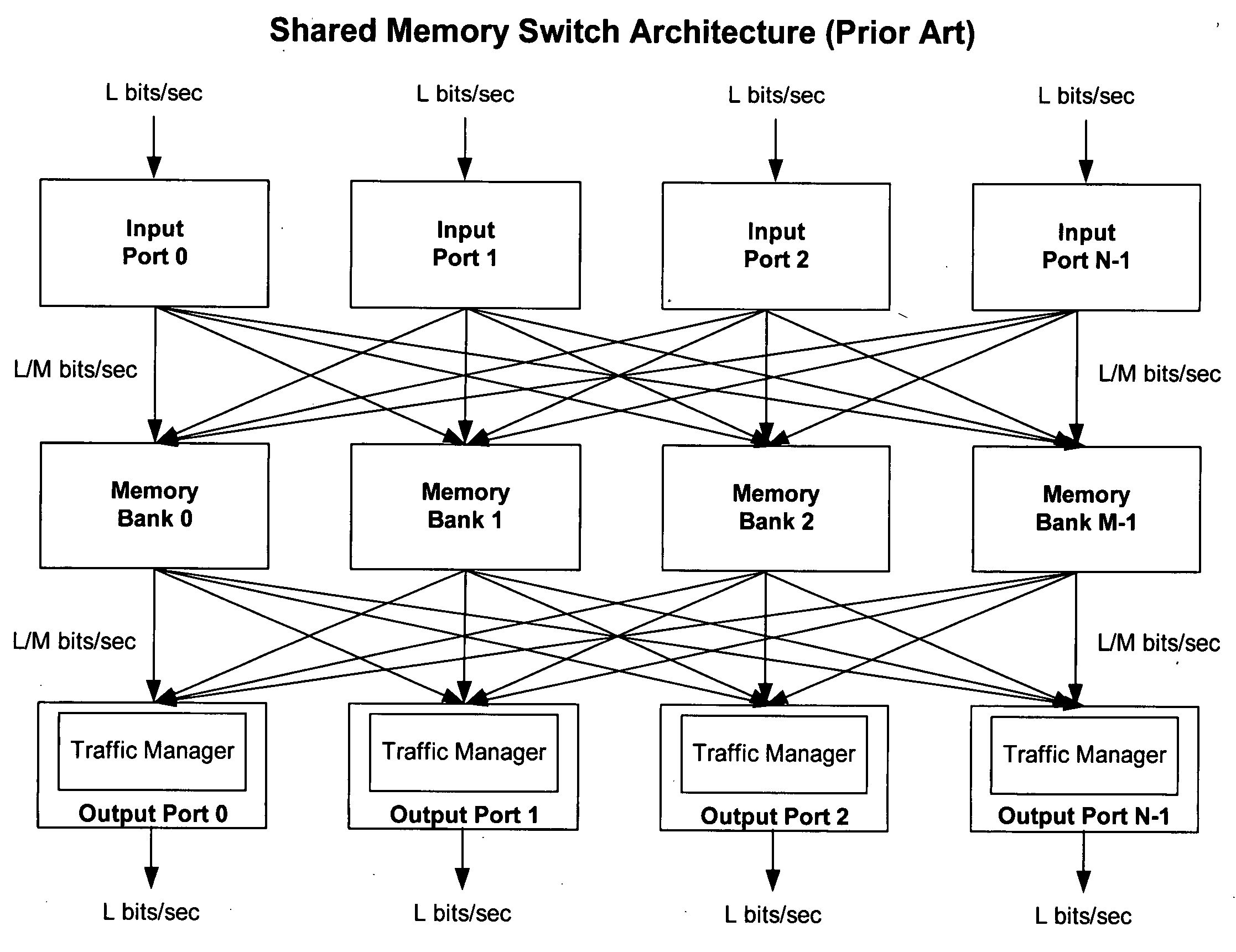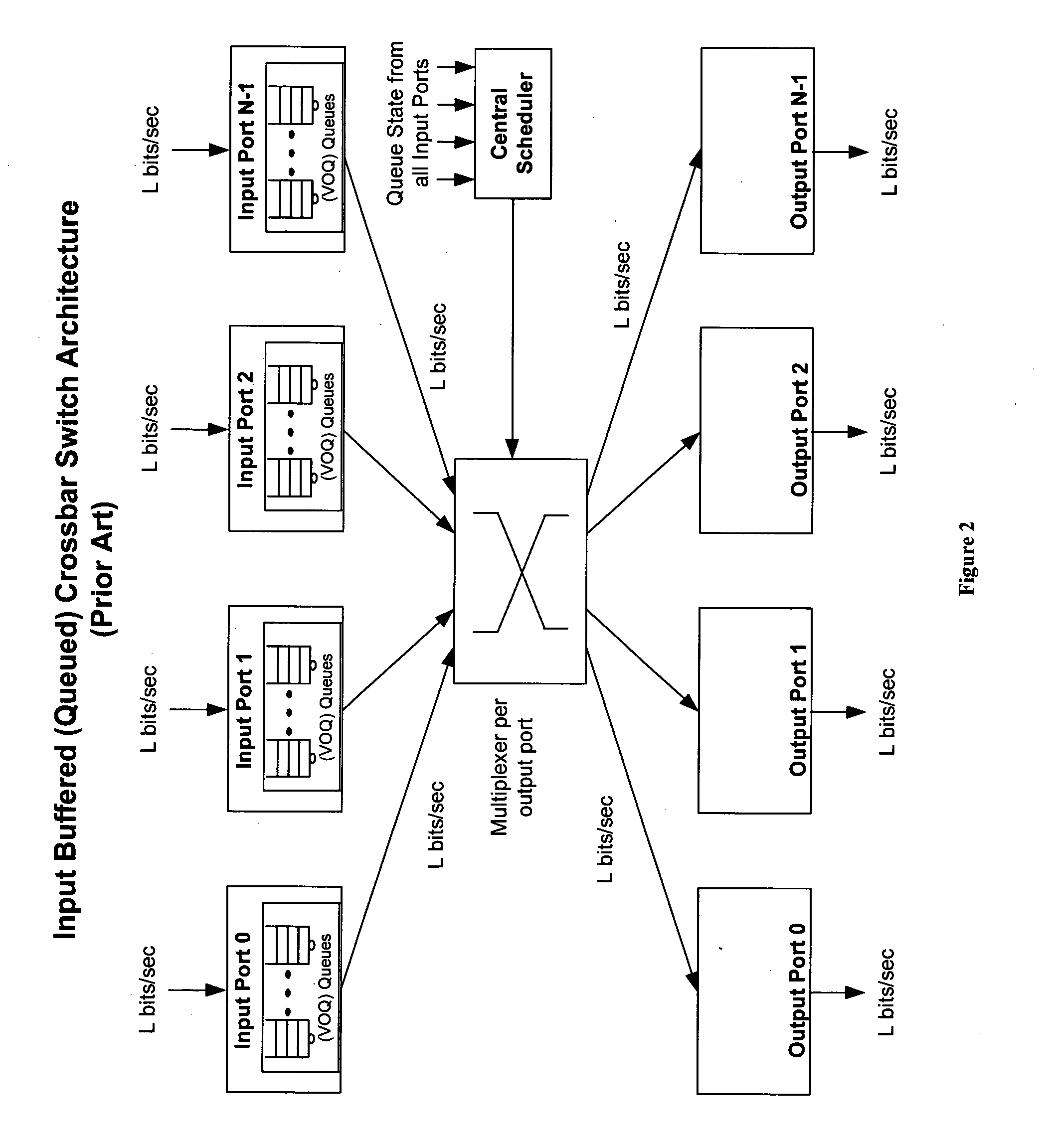Fundamentally, data rates and port densities have grown drastically resulting in inefficient systems due to congestion between ingress or input and egress or output (I / O) ports.
For large values of N and L, however, an ideal output-buffered switch is not practically implementable from an interconnections and
memory bandwidth perspective.
If multiple ingress ports request access to the same egress port simultaneously, however, the switch fabric must decide which ingress port will be granted access to the respective egress port and therefore must deny access to the other ingress ports.
Thus, crossbar-based architectures have a fundamental head-of-line blocking problem, which requires buffering of data packets into
virtual output queues (VOQs) on the ingress port card during over-subscription.
Even though priority is a consideration, these schedulers are not, in practice, capable of controlling bandwidth on a per
queue basis through the switch, a function necessary to provide the desired per
queue bandwidth onto the output line.
This, of course, is far more complex than simply providing
throughput, and low latency and
jitter cannot be guaranteed if the per
queue bit-rate cannot be guaranteed.
The integration of
bandwidth management features into a central scheduler, indeed, has overwhelming implementation problems that are understood by those skilled in the art.
For traffic scenarios where the over-subscription is greater then 4×, however, packets build up in the VOQs on the ingress ports, thus resulting in the before-mentioned problems of the conventional crossbar.
As a result, QOS cannot be guaranteed for many traffic scenarios.
Another important
weakness is that an egress port may not be oversubscribed but instead may experience an instantaneous burst of traffic behavior that exceeds the 4× overspeed.
Practically,
shared memory switch architectures to date, however, have other significant problems that have prevented offering the ideal QOS and
scalability that is required by next generation applications.
Prior art approaches to deal with the challenges in the control architecture in
actual practice have heretofore centered upon the use of a centralized control path, with the complexities and limitations thereof, including the complex control path infrastructure and overhead that are required to manage a typical shared-
memory architecture.
In the case of small minimum size packets equal to a
cell size, however, wherein subsequent packets are all going to different queues and the current state of the central scheduler is such that all the write pointers happen to be pointing to the same
memory bank, every
cell will be sent to the same
bank, developing a worst-case burst.
This scheme therefore does not guarantee a non-blocking write path for all traffic scenarios.
While a FIFO per
memory bank may absorb the burst of cells such that no data is lost, this is, however, at the expense of latency variation into the shared memory.
Even this technique, moreover, while working fine for today's or current routers with requirements of the order of a thousand plus queues, introduces
scalability and latency problems for scaling the number of queues by, for example, a factor of ten.
In such a case, FIFOs sitting in front of the
memory bank would have to be 10,000 times the
cell size, resulting in excessively large latency variations, as well as scalability issues and expense in implementing the required memories.
Furthermore, while this approach simplified the control path in some ways, it still requires a centrally located compute intensive scheduler with communication paths between ingress and egress ports.
Although this is more efficient than a full mesh topology,
system cost, implementation and scalability are impacted by the requirement for more links, board real estate and
chip real estate for the scheduler.
The before-mentioned
datapath problem, however, is directly related to the placement of cells across the banks due to a fixed scheduler scheme (FIG. 7) and thus the organization within a
bank is not relevant because both schemes experience the same problem.
Such fragmented cell placement within a queue seriously compromises the ability of the
system to deliver QOS features as in FIG. 7.
This obviously seriously compromises QOS.
Another problem that can arise in the above-mentioned prior art schemes is that cells within a queue can be read from the shared memory out of order.
This will require expensive reordering logic on the output port and also limits scalability.
Such techniques all have their complexities and limitations, including particularly the complex control path infrastructure and the overhead required to manage typical shared-memory architectures.
The cells are written across the M memory banks I+1 up to j cells, while the central scheduler increments the
write pointer by j. As described before, this load-balancing scheme, however, can deleteriously introduce contention for a bounded time period under certain scenarios, such as where the central scheduler write pointers for all queues that happen to synchronize on the same memory
bank, thus writing a burst of cells to the same memory bank.
A complex scheduling
algorithm is indeed required to process N requests simultaneously, regardless of the incoming
data rate and destination.
In summary, control messaging and
processing places a tremendous burden on prior art systems that necessitates the use of a control plane to message addresses or pointers in a non-blocking manner, and requires the use of complex logic to sort addresses or pointers on a per queue basis for the purpose of enqueuing, gathering knowledge of queue depths, and feeding this all to the bandwidth manager so that it can correctly dequeue and read from the memory to provide QOS.
On the issue of preventing over-subscribing a memory bank, moreover, the invention provides a data write path that, unlike prior art systems, does not require the
data input ports to write to a predetermined memory bank based on a load-balancing or fixed scheduling scheme, which may result in a fragmented placement of data across the shared memory and thus adversely affect the ability of the output ports to read up to the full output line-rate.
 Login to View More
Login to View More  Login to View More
Login to View More 


